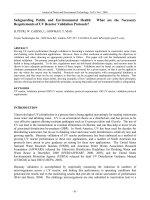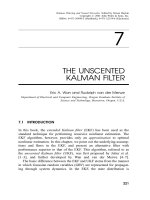Electronic starters and variable speed drives ATV71 the motor control
Bạn đang xem bản rút gọn của tài liệu. Xem và tải ngay bản đầy đủ của tài liệu tại đây (2.38 MB, 111 trang )
Training module 3
The motor control
Dominique GENDRON
François MALRAIT
12/28/15 Bertrand Guarinos STIE
ATV71 M3 commande moteur R2 EN
Summary
1
Introduction
ATV71
The ATV71 includes several motor control laws.
These different laws allow the drive to be adapted to a great variety
of induction motors and machines.
This module describes these command law, their application, as
well as their associated functions.
Summary
Summary
ATV71
I.
The motor control laws
II.Motor control menu
III.
Protection against motor o
ver v oltage
IV.Specific applications
Summary
The motor control
I.
ATV71
The motor control laws
•
•
•
•
•
The basics of flux vector control
The voltage flux vector control law SVC U
The current flux vector control law SVC I
The volts/Hertz law (U/f)
The synchronous motor law
II.Motor control menu
III. Protection against motor
over v oltage
IV. Specific applications
Summary
The motor control laws
ATV71
Flux vector control basics
Summary
Flux vector control basics
ATV71
•
The control of an asynchronous motor is made more difficult by the fact that
the electrical parameters (current, voltage, flux) are alternating.
•
Furthermore, flux and torque are dependant upon current.
•
The principal of flux vector control consists in transforming the machine
equations in such a fashion so as to::
– use variables as though the are continuous and no longer alternating,
– simplify the equations in order to decouple the flux and torque variables.
Flux φ r = K1 Id
Torque C = K2 φ s Iq
•
Flux is proportional to the Id component of current.
•
If the flux is constant, the torque is proportional to the Iq component of
current.
Summary
Flux vector control basics
•
•
•
ATV71
Vector control allows the controller to separate the torque producing current and the
flux producing current
This is analogous to a DC motor with separate excitation.
Flux is maintained constant and set at a point to obtain constant torque over the entire
speed range.
Asynchronous
Motor
DC Motor
Φr
Φr
Φs
I inductive
I induced
Φs
Id Flux
Torque
Iq
•
•
The vector control has a speed estimation function that allows the full time
correction of torque and flux.
Thus the performance is much better, for low speed torque, dynamic response,
and speed precision compared to a scalar volts/Hertz law.
Summary
Flux vector control basics
ATV71
Comparison of U/F and Vector control
Flux Vector Control
U/F Law
Automatic Compensation
(Rs and slip)
Manual Compensation
(U0 voltage at origin)
C/Cn
C/Cn
200 %
100%
F hz
1 3
FrS
F hz
5
10
FrS
Summary
Flux vector control basics
ATV71
Torque/current relationship
•
The link between current/torque is dependent upon the type and size of the motor as
well as the optimization of the command law.
Example for a motor with Id = 50% of In
Torque
220%
2 In
Typical Values
162%
100%
0%
1.5 In
In
0.5 In
50%
"Id" = Flux
Summary
The motor control laws
ATV71
Voltage vector control law SVC U
Summary
Voltage vector control (CTT=SVC U)
ATV71
•
Voltage vector control is a compromise between performance and robustness.
•
It is compatible with that of the ATV58.
•
It functions only in open loop
Applications :
•
•
•
•
•
•
Hoisting
General material-handling equipment
Machines requiring low speed torque
Motors in parallel, synchronous with reluctance
Unbalanced loads with the ENA function
Replacement of the ATV58 …
Summary
Voltage Vector Control (CTT=SVC U)
ATV71
Performance :
•
Good dynamic characteristics
•
Overtorque from 170% to more than 200%, depending upon the motor and
the optimization of the settings (current limit adjustable from 150% to 165%
In of the drive)
•
Nominal torque down to 1Hz, (0,5hz with optimization)
•
Maximum frequency of 500Hz
•
Speed precision =<10 % of slip
•
Speed range 50 (100 with optimization)
•
It can be used with motors in parallel.
Summary
Voltage vector control (CTT=SVC U)
ATV71
Performance :
•
The speed range in generator mode depends on motor slip
•
Speed feedback by sensor allows the improvement of static speed precision
and insures sway detection.
•
Band pass:
•
– 0.37 to 2.2kW
15Hz
– 3 to 7.5kW
12Hz
– 7.5 to 75kW
10Hz
– 280 kW
– 500 kW
4 Hz
2 Hz.
This performance is guaranteed for a motor of the same size than the motor
and up to one size below.
Summary
Voltage vector control (CTT=SVC U)
Flux
Calculation
Φ ref
ATV71
Id ref
Current
Sensors
Voltage
Calculation
Ω cons
Speed
Ramp
+
-
Speed
Regulation
Id
Ω est
Iq ref
Current
Regulation
Va
Vd, Vq
(d,q)
Vb
(a,b,c) Vc
PWM
Motor
Current/torque
Limitation
+
Integration
Θs
+
Iq
Speed
Estimate
Slip
Compensation
Id Iq
Current
measurement
(d,q) (a,b,c)
Summary
Voltage vector control (CTT=SVC U)
ATV71
Torque curves (11kW 400V motor quadrant)
Summary
Voltage vector control(CTT=SVC U)
ATV71
Torque curves (11kW 400V motor quadrant 0-5Hz)
Summary
The motor control laws
ATV71
Current vector control law SVC I and FVC
Summary
Current vector control
ATV71
•
The current vector control law allows the drive to attain better static and dynamic performance for
torque and speed.
•
Requires a good understanding of the motor characteristics
•
It is compatible with the ATV58F
•
It functions in open or closed loop
Applications :
•
•
•
•
•
Vertical hoisting movements
High process rate machines
Rapid material-handling
Positioning
Base law for the torque control function
Summary
Current vector control
ATV71
Performance :
•
Very good dynamic speed and torque characteristics
•
Overtorque from 170% to more than 200%, depending on the motor and the
optimization of the settings (current limit adjustable from 150% to 165% In drive)
•
Maximum frequency 500Hz
•
The motor nameplate information and TUN are required.
•
Flux feedback permits the improvement of braking performance without a braking
resistor.
Summary
Current vector control (CTT=SVC I)
ATV71
Performance in open loop
•
The general performance is comparable to voltage vector control.
•
Always with better torque precision and better defluxed braking.
•
Can be used with motors in parallel if the motors are identical
•
Nominal torque down to 1Hz, (0,5hz with optimization)
•
Speed precision =<10 % of slip
•
Speed range 50 (100 with optimization)
•
Torque regulation mode :
– Precision 15%
– Up to +/-300% of nominal torque (Cn)
Summary
Current vector control (CTT=SVC I)
ATV71
Open loop
Φ ref
Estimate of
magnetizing
inductance
Flux
Calculation
Id ref
Voltage
calculation
Id
Ω cons
Speed
Ramp
+
-
Speed
Regulation
Id
Ω est
Current
sensors
Iq ref
Current
regulation
Va
Vd, Vq
(d,q)
Vb
(a,b,c) Vc
PWM
Motor
Current/torque
Limit
+
Integration
Θs
+
Iq
Speed
Estimation
Slip
Compensation
Id Iq
current
measruement
(d,q) (a,b,c)
Summary
Current vector control (CTT=SVC I)
ATV71
Torque curves in open loop (motor quadrant 11kW)
Summary
Current vector control (CTT=SVC I)
ATV71
Torque curves in open loop (motor quadrant 11kW 0-5Hz)
Summary
Current vector control (CTT=FVC)
ATV71
Performance in closed loop
•
Torque at 0 speed is available in motoring or generating quadrant
•
Speed precision is 0,02%* of the nominal speed
•
Speed range 1000*
•
Band pass:
– 0.37 to 2.2kW
50Hz
– 3 to 7.5kW
30Hz
– 7.5 to 75kW
15Hz
– 280 kW
8 Hz
– 500 kW
5 Hz
•
Cannot be used with motors in parallel.
•
Torque regulation mode :
– Precision 5%
– Up to +/-300% of nominal torque (Cn)
* Indicative values dependent upon the resolution of the encoder
Summary
Current vector control (CTT=FVC)
ATV71
Closed loop
Φ ref
Estimate of
magnetizing
inductance
Flux
Calculation
Id ref
Voltage
Calculation
Id
Ω cons
Speed
Ramp
+
-
Iq ref
Speed
Regulation
Id
Current
sensors
Current
Regulation
Va
Vd, Vq
(d,q)
Vb
(a,b,c) Vc
PWM
Motor
Encoder
Current/torque
Limitation
+
Ω est
Integration
Θs
+
Speed
Measure
Iq
Slip
Compensation
Id Iq
current
measurments
(d,q) (a,b,c)
Summary









![Structures and electronic properties of si nanowires grown along the [1 1 0] direction role of surface reconstruction](https://media.store123doc.com/images/document/14/rc/td/medium_tdu1394959072.jpg)